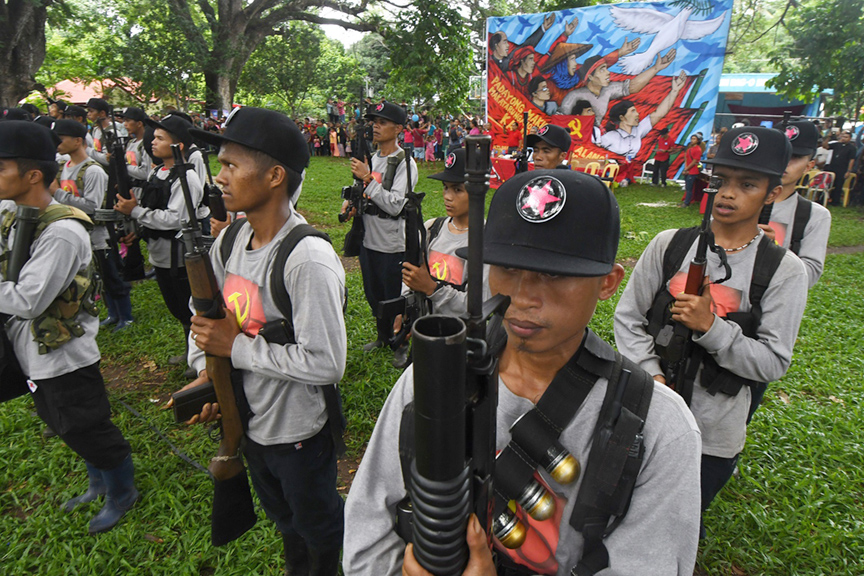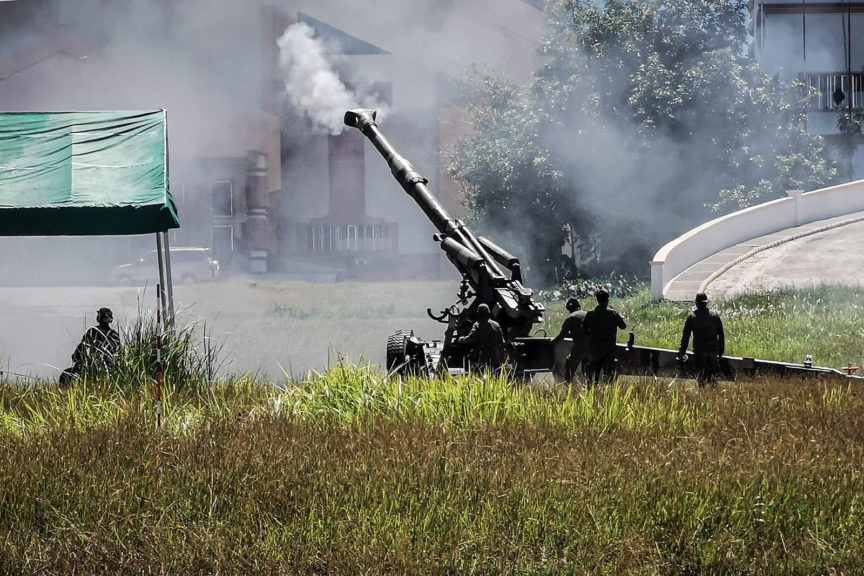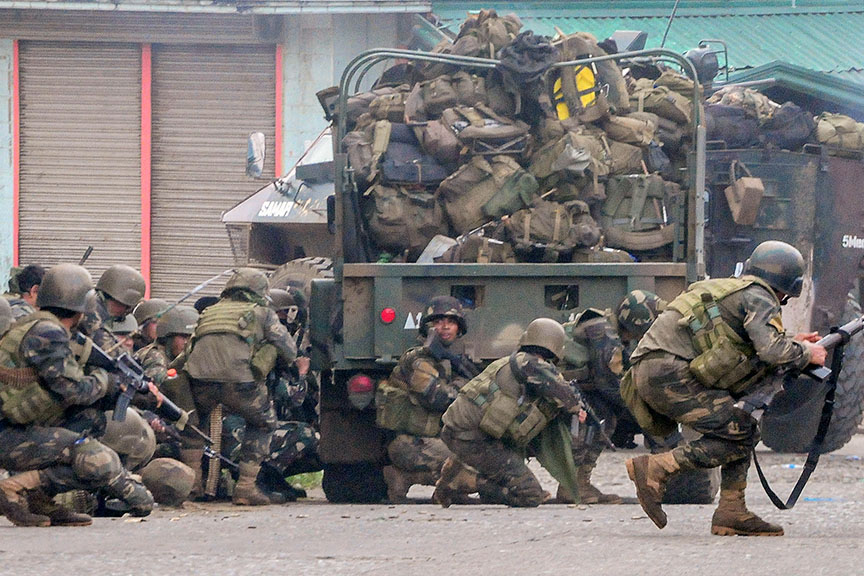From MindaNews (Aug 27, 2021): Journalists urged to foster peace in Mindanao (By BONG S. SARMIENTO)

NPA guerillas. MindaNews file photo by FROILAN GALLARDO
Media practitioners must play an active role in fostering peace in Mindanao, which, in the national consciousness, is considered the country’s war zone, a veteran Mindanawon journalist stressed Friday.
Carolyn Arguillas, MindaNews editor-in-chief, stressed the important role of journalists in peace building as she walked over a dozen Mindanawon media practitioners from the print and broadcast industries down the complex peace process in Mindanao under seven presidents —from Ferdinand Marcos (+) , Corazon Aquino (+) , Fidel Ramos, Joseph Estrada, Gloria Arroyo, Benigno Aquino III (+) and Rodrigo Duterte.
“All of us are stakeholders and are supposed to be part of the cast of characters in pushing for peace in Mindanao,” Arguillas said during the “Training on Safety in Covering Peace and Conflict in Mindanao.”
“We should not just leave it to the peace panels or the sundalo (soldiers) or the rebelde (rebels) and the national and local governments. It really requires that all of us get involved in this and in particular, on how we cover these conflicts and peace processes as journalists,” she added.
Arguillas noted the need for journalists to have a firm grasp of the historical background or the signed peace agreements and related documents for better reportage or contextualization of the situation in Mindanao.
The decades-old armed rebellion in Mindanao waged by the Moro National Liberation Front (MNLF) and the Moro Islamic Liberation Front (MILF) put the island in the headlines. Eventually, the Philippine government had separately forged peace deals with the two groups in 1996 and 2014, respectively.
Media practitioners must play an active role in fostering peace in Mindanao, which, in the national consciousness, is considered the country’s war zone, a veteran Mindanawon journalist stressed Friday.
Carolyn Arguillas, MindaNews editor-in-chief, stressed the important role of journalists in peace building as she walked over a dozen Mindanawon media practitioners from the print and broadcast industries down the complex peace process in Mindanao under seven presidents —from Ferdinand Marcos (+) , Corazon Aquino (+) , Fidel Ramos, Joseph Estrada, Gloria Arroyo, Benigno Aquino III (+) and Rodrigo Duterte.
“All of us are stakeholders and are supposed to be part of the cast of characters in pushing for peace in Mindanao,” Arguillas said during the “Training on Safety in Covering Peace and Conflict in Mindanao.”
“We should not just leave it to the peace panels or the sundalo (soldiers) or the rebelde (rebels) and the national and local governments. It really requires that all of us get involved in this and in particular, on how we cover these conflicts and peace processes as journalists,” she added.
Arguillas noted the need for journalists to have a firm grasp of the historical background or the signed peace agreements and related documents for better reportage or contextualization of the situation in Mindanao.
The decades-old armed rebellion in Mindanao waged by the Moro National Liberation Front (MNLF) and the Moro Islamic Liberation Front (MILF) put the island in the headlines. Eventually, the Philippine government had separately forged peace deals with the two groups in 1996 and 2014, respectively.

Joint Task Force Central fires artillery rounds towards suspected positions of an Islamic State-inspired terror group in Maguindanao on 11 March 2020. MindaNews file photo by FERDINANDH CABRERA
Mindanao is also home to the most number of guerilla fronts of the New People’s Army, the armed wing of the Communist Party of the Philippines. The island also hosts the Abu Sayyaf, the Bangsamoro Islamic Freedom Fighters (BIFF), Maute Group, which led the devastating Marawi Siege in 2017, and some other groups allied with the Islamic State.
In covering conflict, Arguillas, recipient of the Canadian Embassy’s Marshall McLuhan Award in 2011 for her collective body of work in journalism, noted the importance of preparation and knowledge of the area for journalists to come out safely from danger zones.
“A major part of it is really knowing what you are going to cover — what’s the context, the background — before proceeding,” she said.
“A good coverage is really about knowing what is happening, for example in the peace negotiations, and at the same time going to the field to see the reaction of ordinary people or the civilians who often evacuate (in the course of) that peace negotiations,” she added.
MindaNews’ Froilan Gallardo, another veteran journalist in Mindanao, shared his thoughts in covering the communist insurgency.
“Be wary of mortar shelling,” he said, noting that reporters should also have an idea on the capability of certain types or artillery when in conflict zones.
Light mortar has an effective range of one kilometer while the heavy M114 155 mm howitzer can hit targets 15 kilometers away, according to him.
A 750-pound bomb from an FA-50 fighter jet can create a crater that can fit two Army trucks and four Army trucks for a 1000-pounder bomb, he added.
Mindanao is also home to the most number of guerilla fronts of the New People’s Army, the armed wing of the Communist Party of the Philippines. The island also hosts the Abu Sayyaf, the Bangsamoro Islamic Freedom Fighters (BIFF), Maute Group, which led the devastating Marawi Siege in 2017, and some other groups allied with the Islamic State.
In covering conflict, Arguillas, recipient of the Canadian Embassy’s Marshall McLuhan Award in 2011 for her collective body of work in journalism, noted the importance of preparation and knowledge of the area for journalists to come out safely from danger zones.
“A major part of it is really knowing what you are going to cover — what’s the context, the background — before proceeding,” she said.
“A good coverage is really about knowing what is happening, for example in the peace negotiations, and at the same time going to the field to see the reaction of ordinary people or the civilians who often evacuate (in the course of) that peace negotiations,” she added.
MindaNews’ Froilan Gallardo, another veteran journalist in Mindanao, shared his thoughts in covering the communist insurgency.
“Be wary of mortar shelling,” he said, noting that reporters should also have an idea on the capability of certain types or artillery when in conflict zones.
Light mortar has an effective range of one kilometer while the heavy M114 155 mm howitzer can hit targets 15 kilometers away, according to him.
A 750-pound bomb from an FA-50 fighter jet can create a crater that can fit two Army trucks and four Army trucks for a 1000-pounder bomb, he added.

Army Scout rangers take cover behind a military truck after Maute gunmen fired shots at them in Marawi City on 27 May 2017. MindaNews photo by FROILAN GALLARDO
Gallardo lamented the difficulty of having been red-tagged, or labeled a communist, apparently by elements from the Armed Forces of the Philippines.
“It’s terrible. Suddenly your photos appear in leaflets distributed in churches and other public places,” he said.
Ferdinandh Cabrera, a video stringer for GMA News, said that one of the root causes of the security problems in Maguindanao, a province under the Bangsamoro Autonomous Region in Muslim Mindanao, is land conflict.
“Land conflict had triggered rido (bloody family feud). It is a major source of armed conflict (among families),” he said.
Cabrera said it is important to get the help of locals familiar with the terrain to avoid getting trapped while covering conflict situations. In January 2021, he and his team came out from a remote village in South Upi unhurt, after the town mayor and his convoy was ambushed by BIFF fighters. One person died while four others were injured from the mayor’s convoy.
Cabrera’s team did not join the convoy. They rented motorcycles driven by locals to go out of the danger zone unharmed.
The safety training in covering peace and conflict is the last of a four-series training in Mindanao on “Strengthening Safety of Journalists and Professional Journalistic Standards in the Philippines,” a project of the United Nations Educational, Scientific and Cultural Organization (UNESCO) -Jakarta supported by the Netherlands Funds-in-Trust, in partnership with MindaNews.
Already completed were the Safety Training in Covering the COVID-19 Pandemic, Safety Training in Covering Disasters and Digital Safety. (Bong S. Sarmiento / MindaNews)
Gallardo lamented the difficulty of having been red-tagged, or labeled a communist, apparently by elements from the Armed Forces of the Philippines.
“It’s terrible. Suddenly your photos appear in leaflets distributed in churches and other public places,” he said.
Ferdinandh Cabrera, a video stringer for GMA News, said that one of the root causes of the security problems in Maguindanao, a province under the Bangsamoro Autonomous Region in Muslim Mindanao, is land conflict.
“Land conflict had triggered rido (bloody family feud). It is a major source of armed conflict (among families),” he said.
Cabrera said it is important to get the help of locals familiar with the terrain to avoid getting trapped while covering conflict situations. In January 2021, he and his team came out from a remote village in South Upi unhurt, after the town mayor and his convoy was ambushed by BIFF fighters. One person died while four others were injured from the mayor’s convoy.
Cabrera’s team did not join the convoy. They rented motorcycles driven by locals to go out of the danger zone unharmed.
The safety training in covering peace and conflict is the last of a four-series training in Mindanao on “Strengthening Safety of Journalists and Professional Journalistic Standards in the Philippines,” a project of the United Nations Educational, Scientific and Cultural Organization (UNESCO) -Jakarta supported by the Netherlands Funds-in-Trust, in partnership with MindaNews.
Already completed were the Safety Training in Covering the COVID-19 Pandemic, Safety Training in Covering Disasters and Digital Safety. (Bong S. Sarmiento / MindaNews)
https://www.mindanews.com/top-stories/2021/08/journalists-urged-to-foster-peace-in-mindanao/

No comments:
Post a Comment
Note: Only a member of this blog may post a comment.